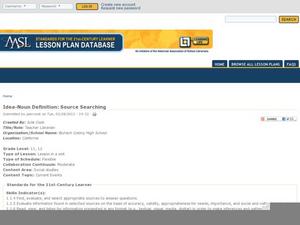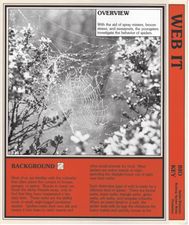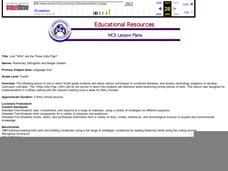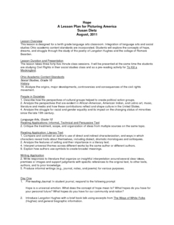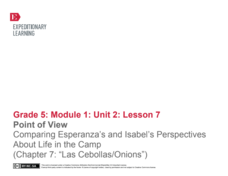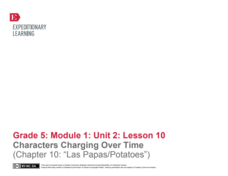Curated OER
Historical Fiction Project
Students be engaged in a history project that is combined with Language Arts with the purpose of teaching students how to cite bibliographic information. This is important for doing future research.
Curated OER
Idea-Noun Definition: Source Searching
A great idea for showing language arts pupils the universality of themes, even in the real world! Have class members choose an idea-noun (peace, justice, war, love, etc.) at the beginning of the year or semester. They complete weekly...
Curated OER
Web It!
Looking for a way to bring prewriting into your informative writing unit? Use this lesson to reinforce writing skills in your eighth grade language arts class. Young writers use a web graphic organizer as a prewriting tool for expository...
Curated OER
The All About Me Poster
First and second graders become familiar with the components of a biography. In this language arts lesson, pupils create an "All About Me" page using components of a biography. They also create an interractive poster, and work with a...
Curated OER
The World Around Me
Combining visual and language arts, here is a resource that prompts middle schoolers to write stories based on pictures of their surroundings. They use digital cameras to take pictures of favorite areas in the school. Next, they choose...
Curated OER
What is a Haiku? How Do You Write a Haiku?
Haiku poetry is explored in this language arts lesson. Yong readers identify the characteristics of haiku and read several examples. Students make connections between their study of Japan and the poetic form of haiku, and they write...
Curated OER
Just "Who" are the Three Little Pigs?
Fourth graders use a Venn diagram to compare and contrast various versions of the story The Three Little Pigs. They write a Cinquain, and then act out their version of the Three Little Pigs in a skit.
Curated OER
Proofreading: Lesson 2
Identify and develop strategies for proofreading with your class. They read and identify the grammar rules for capitalization, end punctuation, and commas, correct errors as a class, and complete three worksheets. This resource includes...
Georgia Department of Education
Exploring Poetry and Poets
Combine the study of poetry and non-fiction texts with this complete and ready-to-use six-week unit. After reading numerous poems from local writers and compiling a personal anthology, high schoolers find and read a memoir or biography...
EngageNY
Analyzing Text Structure: “Water Is Life” Paragraphs
Water, water everywhere. Readers revisit paragraphs six through nine in the article "Water is Life" to answer text-dependent questions. They then pair up to reread the article focusing on its structure and record their thoughts on...
Curated OER
Picturing America: Images and Words of Hope from Romare Bearden and Langston Hughes
A carefully crafted three-day lesson plan integrates poetry and visual art. By analyzing and comparing Langston Hughes' poem "Mother and Son" and Romare Bearden's collage "The Dove," readers explore the theme of hope. The lesson plan...
EngageNY
Point of View: Comparing Esperanza's and Isabel's Perspectives About Life in the Camp (Chapter 7: "Las Cebollas/Onions")
Explore point of view and more with a Common Core-designed instructional activity. Learners experience different points of view by representing one of two characters from Esperanza Rising during a partner discussion. They must use...
EngageNY
Characters Changing Over Time (Chapter 10: "Las Papas/Potatos")
Engage further in Esperanza Rising with a focus on close reading and metaphor. Class members zero in on the tenth chapter, examining characters and big ideas. Pupils discuss the text in small groups and as a whole class, and participate...
EngageNY
Revisiting Big Metaphors and Themes: Revising and Beginning to Perform Two-Voice Poems
Now that your class has read all of Esperanza Rising, take the time to tackle big metaphors and themes. Pupils will participate in an activity called Chalk Talk, in which they circulate around the room in small groups and add comments to...
EngageNY
Close Reading: Paragraphs 1–5 of “Water Is Life”
Be more specific. Scholars take a look at domain-specific vocabulary by discussing an anchor chart. They then look at vocabulary words recorded from paragraphs one through five in Water of Life. After analyzing the vocabulary used in the...
Curated OER
Through the Eyes of the Big Bad Wolf
Imagine how the wolf would tell the tale of Little Red Riding Hood or The Three Little Pigs. Young writers re-imagine classic tales by adopting the point of view of another character in the story. After reading models like The True Story...
San Francisco Symphony
Music Reflects History
Exploring the baroque era can be exciting and fun when it's done thorugh the arts. Middle schoolers examine the music and art history of the baroque era through research. They use their findings and class notes to create an expository...
EngageNY
Using Informational Text Features and Learning Freaky Frog Vocabulary
What kind of text features help children build a strong vocabulary? Class members use text features such as headers to unpack new vocabulary words. They create vocabulary journals in which they will write what they think the definition...
Curated OER
Fantastic Journeys
Middle schoolers design an amusement park attraction based on a fantastic journey from literature, film, or their own imaginations. Each design team must submit a formal proposal. The proposal should include: a two- or three-dimensional...
Curated OER
Determining Importance
Students hone their skills at identifying the principle story in a work of art and text. Through discussion, students assess the central and supporting stories of a work of art that is characterized by multiple layers of action and meaning.
Curated OER
Beware the Ides of March
Sixth graders pretend to be the oracle warning Caesar about March 15th. They write a letter to Julius Caesar warning him of the consequences of going to the Senate building on March 15th. Students identify three causes and effects that...
Curated OER
Treasure Tales
Create an artifact kit to engage your young learners. Then, assign small groups a section of chapter three. They will identify the main idea and three supporting details for their section. Then, they select one artifact from the kit that...
Curated OER
Introduction to Symbolism
Your young readers might know that the stars on the American flag symbolize the fifty states, but what symbols best represent who your students are as people? Use this SMART board presentation to guide learners through an activity about...
Curated OER
Be Your Own Chief Editor
The value of this punctuation and grammar lesson is in the SMART board presentation, which takes pupils through the proofreading process. It would be a good way to introduce the idea of proofreading in your class before beginning a unit...



